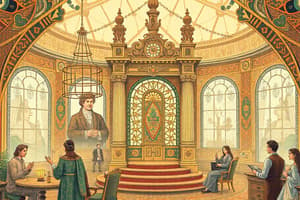Podcast
Questions and Answers
What term refers to a general increase in prices over time?
What term refers to a general increase in prices over time?
- Deflation
- Inflation (correct)
- Disinflation
- Hyperinflation
Which type of inflation is caused by rising production costs?
Which type of inflation is caused by rising production costs?
- Stagflation
- Cost-push inflation (correct)
- Deflation
- Demand-pull inflation
What is the opposite of inflation where prices continuously decrease?
What is the opposite of inflation where prices continuously decrease?
- Deflation (correct)
- Hyperinflation
- Disinflation
- Stagflation
Which term refers to a decrease in the rate of inflation?
Which term refers to a decrease in the rate of inflation?
What is the opposite of demand-pull inflation?
What is the opposite of demand-pull inflation?
Which index measures the price changes for goods and services typically consumed by households?
Which index measures the price changes for goods and services typically consumed by households?
Which type of inflation is influenced by government announcements on prices like fuel?
Which type of inflation is influenced by government announcements on prices like fuel?
What does CPIX exclude from the CPI basket?
What does CPIX exclude from the CPI basket?
Which measure of inflation excludes highly volatile items from the CPI?
Which measure of inflation excludes highly volatile items from the CPI?
What type of inflation occurs due to increased demand exceeding supply?
What type of inflation occurs due to increased demand exceeding supply?
If the manufacturer needs to adjust can price in April 2014 to cover a 6.1 percent inflation rate, which type of inflation is being accounted for?
If the manufacturer needs to adjust can price in April 2014 to cover a 6.1 percent inflation rate, which type of inflation is being accounted for?
'Inflation rate is 6.1 percent' - What does this percentage represent in the given context?
'Inflation rate is 6.1 percent' - What does this percentage represent in the given context?
Flashcards are hidden until you start studying
Study Notes
- Author has written textbooks for grades 10, 11, and 12 and is currently working on a grade 10 business textbook.
- The lesson introduces the topic of inflation as a general increase in prices over time.
- Two types of inflation discussed: demand-pull inflation caused by an increase in aggregate demand and cost-push inflation caused by rising production costs.
- Terms like hyperinflation, stagflation, and deflation are explained as extreme situations related to inflation rates.
- Deflation is described as the opposite of inflation, where prices of goods and services continuously decrease.
- Deflation can discourage investment by impacting businesses' ability to sell goods at a higher price in the future.
- Disinflation is highlighted as a decrease in the rate of inflation, which can be beneficial for the economy.
- Reflection is defined as stimulating the economy through increased money supply or reduced taxes, considered a combination of fiscal and monetary policies.- Inflation rates were discussed for different years: 2010 (3.8%), 2011 (4.5%), 2012 (3.2%), 2013 (-2.2%), 2014 (-1.8%), 2015 (1.8%), and 2016 (1.2% decrease from 1.8%).
- The concept of disinflation was explained where the rate of inflation decreases over time, leading to almost deflation.
- Different types of inflation measurement were discussed: CPI (Consumer Price Index), CPIX, core inflation, administered price inflation, and PPI (Producer Price Index).
- CPI measures the cost of living based on a basket of goods and services, with weightings assigned based on expenditure proportions.
- CPIX excludes mortgage bond interest rates from CPI.
- Core inflation excludes highly volatile items from CPI.
- Administered price inflation is influenced by government announcements on prices like fuel.
- PPI measures the cost of production at the factory gate, excluding transport costs.
- Demand-pull inflation occurs due to increased demand exceeding supply, involving businesses, government, and foreign demand.
- Cost-push inflation is triggered by increased production costs, including labor costs and other factors like natural disasters or imported goods' prices.- Inflation rate is 6.1 percent, manufacturer needs to adjust can price in April 2014 to cover inflation rate
- Next lesson will cover exploring causes of inflation
- Offering textbooks in economics and business studies for grades 10 to 12
- Textbooks available in two versions: complete with answers and no answers
- Offering student t-shirts to those who purchase more than 10 books, looking to expand catalog
Studying That Suits You
Use AI to generate personalized quizzes and flashcards to suit your learning preferences.




